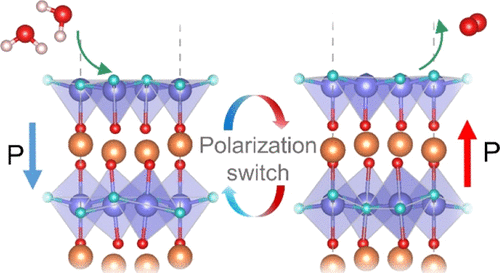当前位置:
X-MOL 学术
›
ACS Catal.
›
论文详情
Our official English website, www.x-mol.net, welcomes your
feedback! (Note: you will need to create a separate account there.)
Enhancing Oxygen Evolution Reaction Activity by Using Switchable Polarization in Ferroelectric InSnO2N
ACS Catalysis ( IF 11.3 ) Pub Date : 2021-10-01 , DOI: 10.1021/acscatal.1c03737 Zhenyun Lan 1 , Didrik René Småbråten 2 , Chengcheng Xiao 3 , Tejs Vegge 1 , Ulrich Aschauer 2 , Ivano E. Castelli 1
ACS Catalysis ( IF 11.3 ) Pub Date : 2021-10-01 , DOI: 10.1021/acscatal.1c03737 Zhenyun Lan 1 , Didrik René Småbråten 2 , Chengcheng Xiao 3 , Tejs Vegge 1 , Ulrich Aschauer 2 , Ivano E. Castelli 1
Affiliation

|
Ferroelectric modulation of the surface charge density is a promising strategy to promote the surface oxygen evolution reaction (OER) in photocatalytic water splitting. The limitations of the Sabatier principle could be overcome by tuning the interaction strength between the OER intermediates and the surface for the individual reaction steps via switching of the polarization direction. InSnO2N, a newly reported improper ferroelectric semiconductor, is promising for applications as a photocatalyst due to its direct band gap of 1.61 eV and its sizable ferroelectric polarization. Therefore, in this work, we use density functional theory to investigate the OER performance on its (001) surface as a function of the bulk polarization direction. We find that the clean surface of the downward (negatively) polarized bulk structure (“polarized bulk” henceforth) has a lower theoretical overpotential of η = 0.58 V versus the standard hydrogen electrode compared to the clean surface with an upward (positively) polarized bulk structure (0.77 V). Under (photo)-electrochemical operating conditions, a monolayer (ML) OH-covered surface is the most stable for the negatively polarized bulk and shows a theoretical overpotential of 0.89 V, whereas for the positively polarized bulk structure, a surface covered with 2/3 ML OH is the most stable, also showing an overpotential of 0.89 V. Notably, when switching the polarization direction during the reaction, the overpotential becomes as small as 0.20 V for the clean surface and 0.23 V for the surface with the OH coverage, which is far below the usual minimum theoretical overpotential for oxides (η = 0.37 V). We show that the reduction in reaction free energy by ferroelectric switching can be performed in a relevant frequency range and outweighs the energetic cost for polarization switching by a factor of 6–12. Our study demonstrates that switching of improper ferroelectricity is a highly promising route to boost the OER activity of oxynitride photocatalytic water splitting electrodes.
中文翻译:

通过在铁电 InSnO2N 中使用可切换极化来增强析氧反应活性
表面电荷密度的铁电调制是促进光催化水分解中表面析氧反应(OER)的一种有前景的策略。Sabatier 原理的局限性可以通过改变极化方向来调整 OER 中间体和各个反应步骤的表面之间的相互作用强度来克服。InSnO 2N 是一种新近报道的不合适的铁电半导体,由于其 1.61 eV 的直接带隙和相当大的铁电极化,有望用作光催化剂。因此,在这项工作中,我们使用密度泛函理论来研究其(001)表面上的 OER 性能作为体极化方向的函数。我们发现,与具有向上(正)极化体的清洁表面相比,向下(负)极化体结构(以下称为“极化体”)的清洁表面与标准氢电极相比具有较低的理论过电位 η = 0.58 V结构 (0.77 V)。在(光)电化学操作条件下,单层 (ML) OH 覆盖的表面对于负极化体最稳定,理论过电位为 0.89 V,而对于正极化的体结构,覆盖有 2/3 ML OH 的表面是最稳定的,也显示出 0.89 V 的过电位。值得注意的是,在反应过程中切换极化方向时,过电位变小至 0.20 V干净的表面和 0.23 V 的 OH 覆盖表面,远低于通常的氧化物的最小理论过电位 (η = 0.37 V)。我们表明,通过铁电开关降低反应自由能可以在相关频率范围内进行,并且比极化开关的能量成本高 6-12 倍。我们的研究表明,不正确的铁电性的转换是提高氧氮化物光催化水分解电极的 OER 活性的非常有前途的途径。覆盖有 2/3 ML OH 的表面是最稳定的,也显示出 0.89 V 的过电势。值得注意的是,在反应过程中切换极化方向时,清洁表面的过电势变小至 0.20 V,而清洁表面的过电势则为 0.23 V。 OH 覆盖的表面,远低于氧化物通常的最小理论过电位 (η = 0.37 V)。我们表明,通过铁电开关降低反应自由能可以在相关频率范围内进行,并且比极化开关的能量成本高 6-12 倍。我们的研究表明,不正确的铁电性的转换是提高氧氮化物光催化水分解电极的 OER 活性的非常有前途的途径。覆盖有 2/3 ML OH 的表面是最稳定的,也显示出 0.89 V 的过电势。值得注意的是,在反应过程中切换极化方向时,清洁表面的过电势变小至 0.20 V,而清洁表面的过电势则为 0.23 V。 OH 覆盖的表面,远低于氧化物通常的最小理论过电位 (η = 0.37 V)。我们表明,通过铁电开关降低反应自由能可以在相关频率范围内进行,并且比极化开关的能量成本高 6-12 倍。我们的研究表明,不正确的铁电性的转换是提高氧氮化物光催化水分解电极的 OER 活性的非常有前途的途径。当在反应过程中改变极化方向时,清洁表面的过电势变小至 0.20 V,OH 覆盖的表面的过电势小至 0.23 V,远低于氧化物通常的最小理论过电势(η = 0.37 V)。我们表明,通过铁电开关降低反应自由能可以在相关频率范围内进行,并且比极化开关的能量成本高 6-12 倍。我们的研究表明,不正确的铁电性的转换是提高氧氮化物光催化水分解电极的 OER 活性的非常有前途的途径。当在反应过程中改变极化方向时,清洁表面的过电势变小至 0.20 V,OH 覆盖的表面的过电势小至 0.23 V,远低于氧化物通常的最小理论过电势(η = 0.37 V)。我们表明,通过铁电开关降低反应自由能可以在相关频率范围内进行,并且比极化开关的能量成本高 6-12 倍。我们的研究表明,不正确的铁电性的转换是提高氧氮化物光催化水分解电极的 OER 活性的非常有前途的途径。这远低于氧化物通常的最小理论过电位 (η = 0.37 V)。我们表明,通过铁电开关降低反应自由能可以在相关频率范围内进行,并且比极化开关的能量成本高 6-12 倍。我们的研究表明,不正确的铁电性的转换是提高氧氮化物光催化水分解电极的 OER 活性的非常有前途的途径。这远低于氧化物通常的最小理论过电位 (η = 0.37 V)。我们表明,通过铁电开关降低反应自由能可以在相关频率范围内进行,并且比极化开关的能量成本高 6-12 倍。我们的研究表明,不正确的铁电性的转换是提高氧氮化物光催化水分解电极的 OER 活性的非常有前途的途径。
更新日期:2021-10-15
中文翻译:

通过在铁电 InSnO2N 中使用可切换极化来增强析氧反应活性
表面电荷密度的铁电调制是促进光催化水分解中表面析氧反应(OER)的一种有前景的策略。Sabatier 原理的局限性可以通过改变极化方向来调整 OER 中间体和各个反应步骤的表面之间的相互作用强度来克服。InSnO 2N 是一种新近报道的不合适的铁电半导体,由于其 1.61 eV 的直接带隙和相当大的铁电极化,有望用作光催化剂。因此,在这项工作中,我们使用密度泛函理论来研究其(001)表面上的 OER 性能作为体极化方向的函数。我们发现,与具有向上(正)极化体的清洁表面相比,向下(负)极化体结构(以下称为“极化体”)的清洁表面与标准氢电极相比具有较低的理论过电位 η = 0.58 V结构 (0.77 V)。在(光)电化学操作条件下,单层 (ML) OH 覆盖的表面对于负极化体最稳定,理论过电位为 0.89 V,而对于正极化的体结构,覆盖有 2/3 ML OH 的表面是最稳定的,也显示出 0.89 V 的过电位。值得注意的是,在反应过程中切换极化方向时,过电位变小至 0.20 V干净的表面和 0.23 V 的 OH 覆盖表面,远低于通常的氧化物的最小理论过电位 (η = 0.37 V)。我们表明,通过铁电开关降低反应自由能可以在相关频率范围内进行,并且比极化开关的能量成本高 6-12 倍。我们的研究表明,不正确的铁电性的转换是提高氧氮化物光催化水分解电极的 OER 活性的非常有前途的途径。覆盖有 2/3 ML OH 的表面是最稳定的,也显示出 0.89 V 的过电势。值得注意的是,在反应过程中切换极化方向时,清洁表面的过电势变小至 0.20 V,而清洁表面的过电势则为 0.23 V。 OH 覆盖的表面,远低于氧化物通常的最小理论过电位 (η = 0.37 V)。我们表明,通过铁电开关降低反应自由能可以在相关频率范围内进行,并且比极化开关的能量成本高 6-12 倍。我们的研究表明,不正确的铁电性的转换是提高氧氮化物光催化水分解电极的 OER 活性的非常有前途的途径。覆盖有 2/3 ML OH 的表面是最稳定的,也显示出 0.89 V 的过电势。值得注意的是,在反应过程中切换极化方向时,清洁表面的过电势变小至 0.20 V,而清洁表面的过电势则为 0.23 V。 OH 覆盖的表面,远低于氧化物通常的最小理论过电位 (η = 0.37 V)。我们表明,通过铁电开关降低反应自由能可以在相关频率范围内进行,并且比极化开关的能量成本高 6-12 倍。我们的研究表明,不正确的铁电性的转换是提高氧氮化物光催化水分解电极的 OER 活性的非常有前途的途径。当在反应过程中改变极化方向时,清洁表面的过电势变小至 0.20 V,OH 覆盖的表面的过电势小至 0.23 V,远低于氧化物通常的最小理论过电势(η = 0.37 V)。我们表明,通过铁电开关降低反应自由能可以在相关频率范围内进行,并且比极化开关的能量成本高 6-12 倍。我们的研究表明,不正确的铁电性的转换是提高氧氮化物光催化水分解电极的 OER 活性的非常有前途的途径。当在反应过程中改变极化方向时,清洁表面的过电势变小至 0.20 V,OH 覆盖的表面的过电势小至 0.23 V,远低于氧化物通常的最小理论过电势(η = 0.37 V)。我们表明,通过铁电开关降低反应自由能可以在相关频率范围内进行,并且比极化开关的能量成本高 6-12 倍。我们的研究表明,不正确的铁电性的转换是提高氧氮化物光催化水分解电极的 OER 活性的非常有前途的途径。这远低于氧化物通常的最小理论过电位 (η = 0.37 V)。我们表明,通过铁电开关降低反应自由能可以在相关频率范围内进行,并且比极化开关的能量成本高 6-12 倍。我们的研究表明,不正确的铁电性的转换是提高氧氮化物光催化水分解电极的 OER 活性的非常有前途的途径。这远低于氧化物通常的最小理论过电位 (η = 0.37 V)。我们表明,通过铁电开关降低反应自由能可以在相关频率范围内进行,并且比极化开关的能量成本高 6-12 倍。我们的研究表明,不正确的铁电性的转换是提高氧氮化物光催化水分解电极的 OER 活性的非常有前途的途径。











































 京公网安备 11010802027423号
京公网安备 11010802027423号